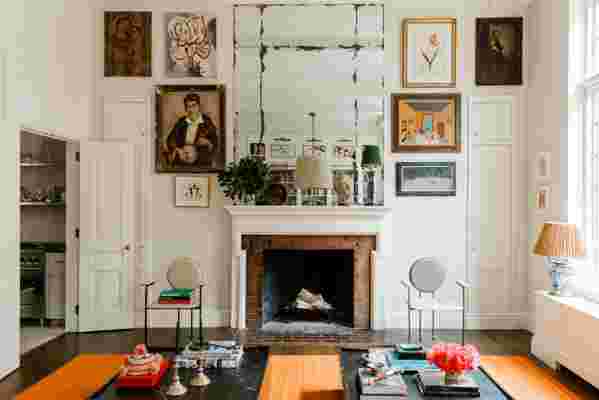“I have always collected things,” shares James Hirschfeld, one of the cofounders of Paperless Post. “When I was a little boy, it was coins. And, then, on from there. The issue this poses when decorating an apartment is that the space becomes a stage for things that I’ve picked up from disparate trips, cultures, time periods, flea markets, and art fairs.”
Charactered interiors and a scale that could embrace these collections were one of the main considerations in Hirschfeld’s home search. He soon discovered this in his one-bedroom residence in Manhattan’s East 70s. Hirschfeld had been raised in this charmed enclave. So in his 30s—in the market for his first home—he returned. For him, there was a sense of romance to his former haunts. “I find that it is fairly under-appreciated by people my age,” he says. “A lot of my friends have settled downtown or in Brooklyn, but the infrastructure of the Upper East Side—Central Park, the museums, the old-school restaurants, the drug and grocery stores—are what define the New York of my childhood. The neighborhood has a cozy draw for me.”

This one-bedroom home boasts a fabulous art collection that continues to evolve. It currently features pieces from the likes of Marcel Dzama and Genieve Figgis.
The prewar pad—which was constructed in the 1920s—boasts classic features, like a brick fireplace and multi-paned windows. Still, there was reason to modernize: Hirschfeld recruited the team from Weil Friedman Architects for this refurbishment. He, then, collaborated with decorator CeCe Barfield—who introduced colors (like the orange couch in the dining/living room) into the interiors. Hirschfeld explains: “I am, sadly, color blind, which is a real pain for a visually inclined person. For me, this means that when I really see and love a color, I get very into it. Hence, all the reds and oranges in the living room. This is a part of the color spectrum that I am really drawn to, though I’m not sure how it looks to other people!”
Indeed, others are drawn to it, too—which is a bonus, since Hirschfeld likes to entertain at home. “I started Paperless Post because I like having parties,” he says. “I enjoy having people over, so having this large, integrated space with high ceilings and big windows fit with my vision for how I wanted to use my home.”

The 12-seat table from Matthew Hilton’s collection for Case Furniture doubles as Hirschfeld’s desk. It’s decorated with Mario Milano’s “dePostura” chairs, which are iron with leather backs. “The craftsmanship is amazing—and I wanted some strong post-1950s pieces to break up the feel of the older objects around the apartment,” says Hirschfeld of the chairs.
One can envision the salon-style events that have been hosted in this well-curated dining-living room. It’s an intimate beacon of arts and culture, with its art and book collections as well as its assorted objets. Hirschfeld was the one who installed the bookcase with the ladder, which features silk panels that he commissioned from artist Larissa Lockshin. “It takes up a lot of space, but I don’t know what I’d do without it, which is funny because we live in a time when most of the information on that shelf is available on our phones,” he says. “Books are information, but they’re also objects. I feel they give a home a personal feel and identity, which is why I have them in the middle of my living room. I studied Comparative Literature in college, so a lot of the books are from that and, then, mixed in with art books and travel guides.”
The dining-living room transitions to the kitchen. Like the bathroom, it has been modernized and smartened with dark green marble and stainless-steel fixtures. “I saw a lot of apartments with kitchens spilling into living rooms over marble islands,” he recalls. “I liked that this one, while small, had a more classic layout—and a door you could shut if you’re frying a steak.”
Situated in the back of the home, the bedroom is oasis-like and soothing: It’s colored in Farrow and Ball’s Lulworth Blue. The shade is echoed in the art—including aquatints and a painting from artist Konstantin Kakanias—and in the headboard’s fabric, Robert Kime’s “Bergama,” which draws influence from the Ottoman Empire.

Styled by Colin King and produced by Jane Keltner de Valle.

Leave a Reply